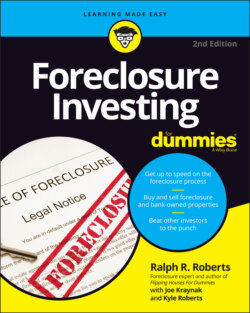Читать книгу Foreclosure Investing For Dummies - Ralph R. Roberts - Страница 39
Exploring the Missed-Payment Notice Stage
ОглавлениеSome lenders initiate foreclosure proceedings as soon as the homeowners miss one or two payments. Other lenders start sending reminder notices, often following a predictable timeline:
Two-week notice: Some lenders give homeowners a two-week grace period, after which they begin to start calling the homeowners or sending them letters.
30-day notice: When a payment is so late that it’s time for the next payment, the lender gets a little jittery and ramps up its efforts. The lender may even begin levying late-payment fees.
45-to-60 days' notice: Unless the homeowners contact the lender and work out some new payment agreement, the lender typically sends out a certified letter insisting that the homeowners pay up.
90-day limit: If the homeowners still haven’t contacted the lender or shown any commitment to make good on the loan, the lender typically initiates formal foreclosure proceedings. At this point, the lender transfers the matter to outside legal counsel (an attorney), and the attorney in charge posts a foreclosure notice, sometimes referred to as a Notice of Default (NOD). As soon as the attorney starts foreclosure by advertisement, these legal notices or advertisements begin to attract investors.
The missed-payment notice stage, before the start of foreclosure proceedings, is the best time for homeowners to act and the best time for you to step in to assist them. In 90 percent or more of the foreclosures I’ve been involved in, the homeowners’ best option is to sell the property, cut their losses, and find more-affordable housing. With your assistance, the homeowners still have time at this stage to take advantage of this option.
